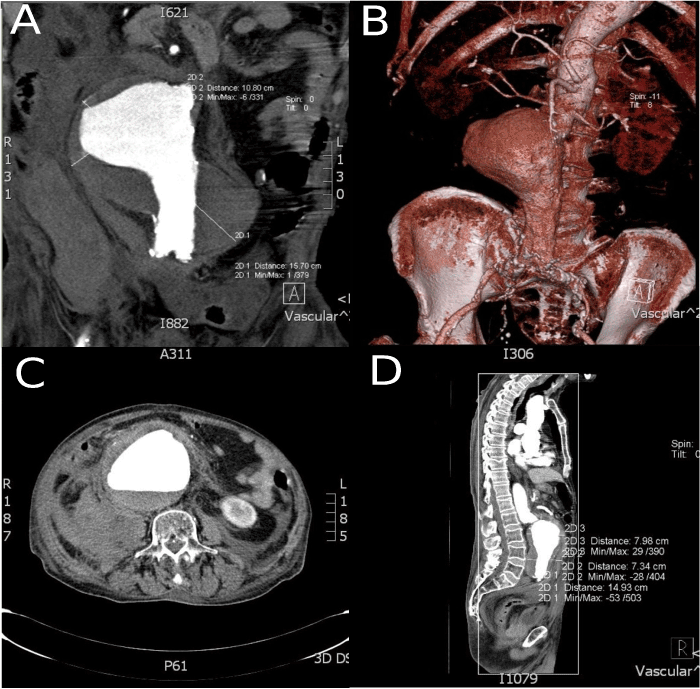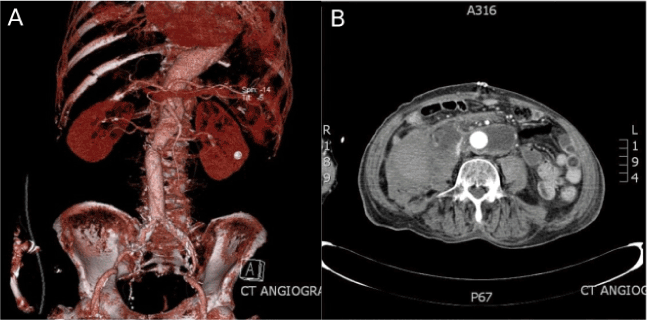A 78-year old man with a medical history of smoking, hyperlipidemia and hypertension was admitted to our department with ruptured abdominal aortic aneurysm (AAA) diagnosed by ultrasonography of the abdomen. The blood pressure was 60/20 mm Hg. An emergent computed tomography scan of the abdomen revealed a rupture of a giant infrarenal AAA of 16 cm in diameter with extensive intraluminal thrombus, evidence of rupture and large intraabdominal hematoma. The patient underwent a successful open surgical repair with placement of a Dacron tube graft 18 mm. The patient was transferred to the intensive care unit following successful surgical repair. Patient was transferred to the Department of cardiovascular surgery on postoperative day 2. Postoperative recovery resulted in hospital discharge at postoperative day 12.
abdominal aortic aneurysm, abdominal aortic aneurysm rupture, abdominal aortic surgery
Abbreviations
AAA: abdominal aortic aneurysm; CTA:computed tomography angiography
The risk of AAA rupture is closely associated with the maximum aneurysm diameter. The annual rupture risk exceeds 14% [1] for aneurysms >6 cm and reaches 30-50% for AAA's exceeding 8 cm in diameter [2]. Undoubtely, the rupture risk of AAA is subject to considerable individual variability [3]. Apart from larger initial maximum aneurysm diameter, other faqctors such as female gender, current smoking status, lower forced expiratory volume in 1 second (FEV 1) as well as higher mean blood pressure are independently associated with the risk of AAA rupture [3]. It is extrremely rare to encounter very large aneurysms exceeding 10 cm in diameter as it is expected that such large aneurysms would have been either previously ruptured or repaired. Notably, under some uncertain protective circumstances AAA may reach extreme diameters up to 26 cm of maximum transverse diameter [4].
A 78-year old man with a medical history of smoking, hyperlipidemia and hypertension was admitted to our department with ruptured abdominal aortic anerysm (AAA) dignosed by ultrasonography of the abdomen. The blood pressure was 60/20 mm Hg. An emergent computed tomography scan of the abdomen revealed a rupture of a giant infrarenal AAA of 16 cm in diameter with extensive intraluminal thrombus, evidence of rupture and large intraabdominal hematoma (Figure 1). Abdominal computed tomography angiography (CTA) with contrast showed a ruptured giant infrarenal AAA measuring 16x11 cm with a large mural thrombus and intra-abdominal hematoma compressing intra-abdominal organs (Figure 1)

Figure 1. Rupture and large intraabdominal hematoma
The patient underwent a succeful open surgical repair with placement of a Dacron tube graft 18 mm (Figure 2). Postoperative CTA with contrast showed complete sealing of the aneurysm with no endoleak detected (Figure 2). The patient was transfered to the intensive care unit following successful surgical repair. Patient was transfered to the department of cardiovascular surgery on postoperative day 2. Postoperative recovery resulted in hospital discharge at postoperative day 12.

Figure 2. Dacron tube graft
Rupture of AAA is a catastrophic event associated with high mortality rate. Majority of patients die without getting to the operating room. Even if they reach operating room alive and undergo surgical repair, only 50% of those survive beyond 30 days [3]. The open surgical repair of the ruptured giant AAA presents challenge due to numeruous significant technical difficulties that complement the huge size of the aneurysm such as short length of the neck and the dislodgement of abdominal organs that may be densely adhered to aneurysma surface sometimes resulting even in fistula formation [5].
Despite being associated with numerous technical difficulties and often hampered with bad outcomes, open surgical repair of ruptured giant AAA is sometimes only available treatment, which if timely performed, results in eventful recovery as in our case.
The patient provided written informed consent for publication of the figures.
The authors declare that there is no conflict of interest.
This work received no specific grant from any funding agency in the public, commercial, or not-fot-profit sectors.
- Brown PM, Zelt DT, Sobolev B (2003) The risk of rupture in untreated aneurysms: the impact of size, gender, and expansion rate. J Vasc Surg 37: 280-284. [Crossref]
- Brewster DC, Cronenwett JL, Hallet JW Jr, Johnston KW, Krupski WC, et al. (2003) Guidelines for the treatment of abdominal aortic aneurysms. Report of a subcommittee of the Joint Council of the American Association for Vascular Surgery and Society for Vascular Surgery. J Vasc Surg 37: 1106-1117.
- Brown LC, Powell JT with The UK Small Aneurysm Trial Participants. Risk factors for aneurysm rupture in patients kept under ultrasound surveillance. Ann Surg 230: 289-96.
- Rodrigues H, Bastos Gonçalves F, Ferreira ME (2014) Giant aneurysm of the abdominal aorta. J Vasc Surg 59: 826-827. [Crossref]
- Maras D, Lioupis C, Moulakakis KG, Sfyroeras G, Pavlidis P, et al. (2009) Giant abdominal aortic aneurysms: clinical and technical considerations. Acta Chir Belg 109: 376-80.


